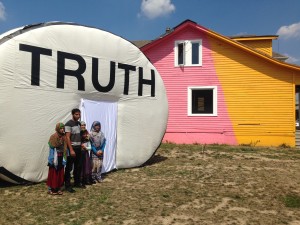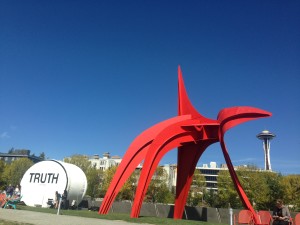Last April, when signs of spring were just beginning to appear on The Greenway, Art Ambassador volunteers were gearing up for one of their largest projects yet. Ambassadors were stationed at the North End of The Greenway with a 25-foot tall inflatable speech bubble, preparing to invite passersby to complete the statement, “The truth is…”
In Search of the Truth (The Truth Booth) invites the public to record themselves finishing the statement “The truth is.…” The Truth Booth is an ongoing, mobile public art work lead by a collaboration of artists including Hank Willis Thomas, Ryan Alexiev, Jim Ricks, and Will Sylvester from the Cause Collective. Since 2011 it has traveled internationally documenting the multiple facets, perspectives, and beliefs layered into the public’s concept of “the truth.”

Each participant has two minutes to record their truth. The recordings are then compiled into videos that reflect the city’s (and country’s) diversity, and prompts an exercise in vulnerability, active listening, and acceptance inside and out of The Truth Booth.
The news that The Truth Booth was coming to Boston caught the attention of two Greenway Art Ambassadors. Helen Banach and Sami Giarratani signed up to volunteer every day the exhibit was in town. Not only did they volunteer when it was on The Greenway, but also at its sister location at the Verb Hotel in the Fenway District.
Both Banach and Giarratani joined the Art Ambassadors Program in 2015 to immerse themselves in a culture of public art and here was their chance. Giarratani, who was working as a high school art teacher, manned The Truth Booth every afternoon after school and Banach took a week off of work to volunteer full time.

Giarratani recalled they spent time engaging people, describing the idea behind the booth and ushering people in and out of the recording studio. Giarratani said she was repeatedly asked “How is The Truth Booth art?” and would respond, “You make it art.”
Banach explained that no matter how deep into a conversation she would get with participants, she could never predict what they would record once inside. Being inside the booth brought out a myriad of reactions from people. Some people spoke seriously, staring intently into the camera; other people used it as a self-promotional ad of sorts; one man immediately began to cry; and one woman confessed that she had just been to her first Red Sox game since her fiancé passed away. The Truth Booth is a space simultaneously intimate and private, yet is also very much a stage projecting participants’ voices into the world.
After a week with the booth, the girls got to know the project and the artists well. They knew that on previous tours the booth did not have designated ushers, so, when Sylvester, a member of the Cause Collective, mentioned the potential for a US tour Giarratani and Banach both jumped at the opportunity and offered to come along and help. “A week later they called,” said Giarratani.

Two months later, in June, they set out with a goal to visit as many US states as possible before Election Day. In four months they made it to 35 states. Giarratani settled into the role of project manager, coordinating the logistics of setting up sites, managing the team, and making sure everyone was well fed. Banach became the tour coordinator and worked out the logistics of connecting with upcoming tour stops—sometimes weeks or days before they would arrive. They each experienced first-hand how to simultaneously teach and learn, effectively communicate, and, most importantly, appreciate the diversity in this country.
Banach remembered how differently the booth functioned in each city. In Boston, she felt people were hesitant and initially thought the booth was selling something, or they were too busy with their commute to interact. However in cities like Detroit and Flint, people were ready and eager to make use of a platform that could amplify a collective voice that usually went unheard.
A woman in Flint, MI earnestly reminded her audience that Flint was not abandoned—that people still live there and that it is a home. “People have a desire to be heard,” Banach said. The booth thrived when it entered neighborhoods condemned as dangerous or underserved because the booth was accessible to everyone. It reasserts that art should be accessible to all neighborhoods and allow everyone to vocalize their beliefs.

The Cranbrook Art Museum in Detroit is continuing The Truth Booth’s work even after it has left. In November the video compilation of the Detroit recordings opened in an exhibition to compliment The Truth Booth’s mission of bringing art out of the formal museum setting by now inviting a nontraditional audience into the formal museum setting.
35 states later, Giarratani said she gained “an understanding of who our country is.” The diversity in the country is obvious when watching the videos, new truth after new truth. Some truths will sit better than others, but the booth asks its audience to find space to accept all truths.
Furthermore, the booth requests that its audience practice separating beliefs from the person who holds and presents them—which was particularly topical during the election.
The Truth Booth exposes the many multiplicities, angles, and layers of “the truth.” The booth suggests that we can create space in our lives to hear and accept different or conflicting viewpoints, and learn to live alongside them.

Neither Banach nor Giarratani are ready to say goodbye to The Truth Booth. Instead, they relocated to New York City to continue working with the Cause Collective. New York promises to bring each of them closer to their goals of immersing themselves in a culture of change-making public art.
Banach said she still returns to what Lucas Cowan, Public Art Curator at the Rose Kennedy Greenway Conservancy, once said: “Good public art should be like a beautiful butterfly: only temporary in nature.”
The Greenway thrives off the ephemeral nature of public art and how temporary pieces flourish over a short lifespan in the public sphere. A limited timeline instills a sense of urgency to see the artwork, which punctures Bostonians’ routines and draws them into a safe and considered space where they are invited to ask questions. Public art on The Greenway challenges our community to unpack social concepts and notions surrounding the status quo and investigate alternatives in our lives.
While the artworks within these spaces of opportunity are temporary, their effects are much longer-lasting. Likewise, while The Truth Booth is temporary and ever-changing, its effects are transformative—for people and places—and that can be a life-changing permanence.




